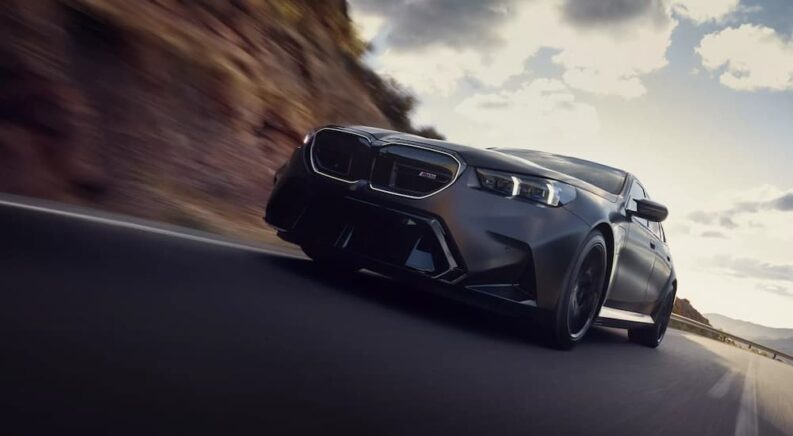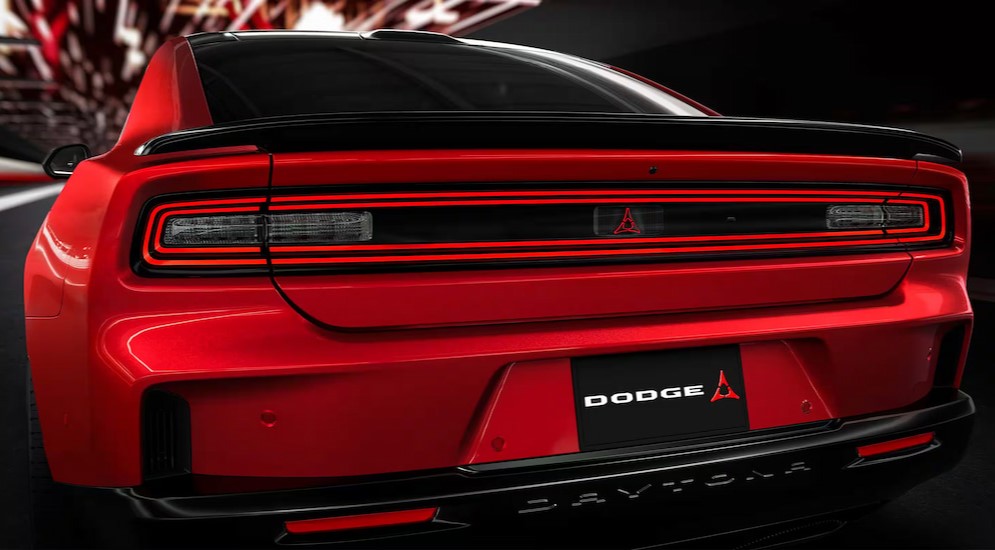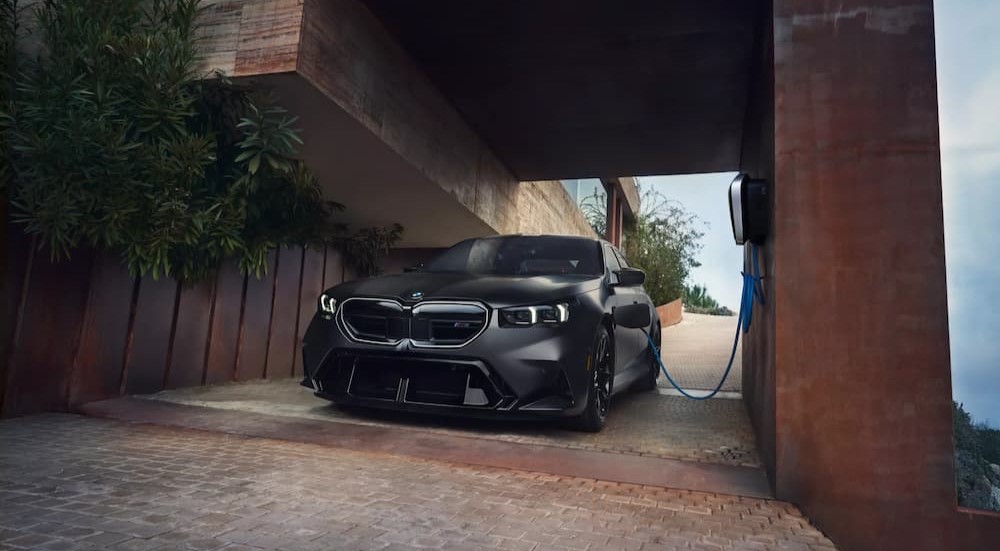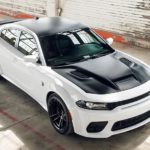These days, high-performance cars are increasingly turning to electrification to give drivers a rush unlike anything else while meeting ever-stricter emissions requirements. BMW and Dodge, two nameplates synonymous with motorsports and other thrill-seeking automotive exploits, have thrown their hats into the ring as they battle to field the ultimate modern street-friendly and eco-friendly performance car. The revamped return of the BMW M5 after a one-year hiatus marks a new era in BMW luxury performance. Meanwhile, Dodge put a twist on its classic NASCAR-inspired vehicle by rolling out the new Dodge Charger Daytona for the 2024 model year.
Each is an impressive take on a high-performance full-size car, giving you plenty of power, precise handling, and slick aerodynamics for any road you want to light up. However, they have taken different routes to electrification. BMW kept its turbocharged V8, pairing it with a plug-in hybrid system, while Dodge ditched the HEMI entirely in favor of a completely electric powertrain. In the end, though, only one can reign supreme. Is the new BMW M5 or the Dodge Daytona the better electrified performance car? I’ve taken a deep dive to see which offers the most thrills.
Raw Power
I’ll begin with how these vehicles operate and how much power they generate as they jet down the highway or around the nearest track. Both utilize cutting-edge technology, albeit in different ways. The new BMW M5 has been reconfigured as a plug-in hybrid electric vehicle (PHEV), combining the 4.4L twin-turbo V8 engine it’s long been known for with an integrated electric motor. This combination produces an ear-splitting 717 hp and 738 lb-ft of torque, which borders on the supercar stratosphere. Even with a weight of 5,390 lbs, you can officially sprint from 0-60 mph in 3.4 seconds and hit a top speed of 190 mph.
As for the Dodge Charger Daytona, it is a fully electric vehicle representing a head-first jump into the automotive future. You can choose between two EV powertrains—but both trail the BMW M5. The Charger Daytona R/T caps out at 496 hp and 404 lb-ft of torque with a 137 mph top speed. As for the Charger Daytona Scat Pack, it gets an upgrade to 670 hp, which lets it beat the 0-60 time of the BMW M5 at 3.3 seconds. However, the top speed is even lower than the R/T at 134 mph (don’t ask me how adding 174 hp can drop the top speed). Purportedly, a Charger Daytona SRT Banshee is in the words that could approach 900 hp, but this won’t be available until at least the 2025 edition.
For now, unless you’re specifically buying a sports car to go to the drag strip, the BMW M5 is a clear choice in this category. For an “everyday” thrill-seeker, giving up a tenth of a second in the 0-60 mph sprint for a top speed increase of nearly 60 mph is more than a fair trade. As an EV, the Charger Daytona may well be more efficient, although official numbers haven’t been released. But be honest—who buys a performance car with efficiency as their primary goal?
Performance and Suspension
Of course, a ton of power only means so much if you can’t control it. With that in mind, it’s time to look at more of the underpinnings of each car. The BMW has an eight-speed automatic transmission to move through the power bands, and all-wheel drive (AWD) is a standard offering. Track purists may grimace at AWD, but a modern driver will appreciate the impressive traction and cornering it offers even when conditions are less than ideal.
AWD is just the tip of the iceberg, though. The automaker’s famed Adaptive M suspension uses electronic shocks, independently adjustable damping, and other features for sharp handling. This design also has less “slop” than regular suspensions and wider tracking to improve stability. You can choose from pre-set modes or create a custom setting. M carbon ceramic brakes are an available upgrade for better stopping power, helping to control the bulk of this vehicle, and with the quad exhaust tips, the M5 sounds like a pure sports car.
Since the Dodge Charger Daytona is an EV, there is no traditional transmission. Instead, it uses a fixed reduction gear ratio, which undoubtedly is part of the reason behind the great 0-60 mph time. AWD is also standard, thanks to having electric motors on both axles. Beyond that, the standard suspension is a bit lacking compared to the M5. It has an independent rear suspension, a multi-link front suspension, and a standard wide-body configuration to fit massive tires. Dodge also adds a pass-through front R-Wing to reduce drag. As a basic package, though, it seems lacking.
That said, you can get the Track Package on the Scat Pack for high-level action. This package upgrades you to a dual-valve adaptive suspension, large Brembo brakes with multi-piston calipers, 20-inch wheels, staggered Goodyear F1 Supercar 3 tires, seven drive modes, and launch control. Dodge even added a Fratzonic chambered exhaust to make the Daytona sound like a classic supercharged muscle car. It’s an impressive setup, and I love the additional pre-configured drive modes that include everything from Drift Mode to Wet/Snow mode. However, almost all the other add-ons are standard features on the M5, and it’s appealing that BMW includes so much right from the get-go.
The verdict here is closer than the raw power category, but I’m still giving the slight edge to the BMW M5 for three reasons. One is that so many more performance features are included in the base package. Second is the slightly larger rear wheels that keep the M5 more balanced under acceleration. Third, with such a lower top speed in a Dodge Charger Daytona, it’s harder to take advantage of many performance features, particularly the R-Wing. However, I’ll have to see what the rumored Daytona Banshee has in store before considering whether to switch my decision.
Get the Best From the BMW M5
BMW has been one of the top-performing brands on the track for decades, scoring wins and championships at the 24 Hours of Le Mans, the 24 Hours of Daytona, the Spa 24 Hours, the British Touring Car Championships, and much more. The return of the BMW M5 affirms this legacy while roaring down the path ahead. While the Dodge Charger Daytona is certainly a solid performance car and a worthy entry into the EV muscle market, it can’t keep up with the BMW M5 over the long haul.
Granted, the BMW M5 costs much more than the Dodge Charger Daytona. The Daytona R/T starts at around $60,000, while the baseline BMW M5 will set you back roughly $120,000. If money is no object, though, the BMW M5 is the choice for serious performance enthusiasts. This M machine also has the latest interior technology as well with a 14.9-inch infotainment screen, a head-up display, a cloud-based navigation system, a full driver assistance package, and video streaming when the vehicle is parked—all of which are features that the Dodge Charger Daytona can’t match.
When you want to drive on the edge, the BMW M5 gets you there fast. It’s a strong daily driver, too. Anyone who appreciates high-end driving and style with modern PHEV technology that doesn’t require finding a charging station to operate should have the M5 on their list of vehicles to test-drive. Still, I reserve the right to revisit this topic if the Charger Daytona Banshee EV comes to fruition, and we have a chance to see whether it delivers on the rumors.






